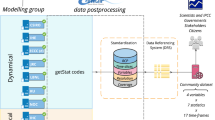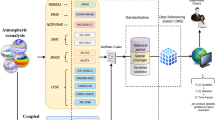Abstract
Despite the widespread interest in data that describes the distribution, frequency, and intensity of tropical cyclones worldwide, until recently no central repository for official data existed. Currently, there are six Regional Specialized Meteorological Center’s (RSMC) and five Tropical Cyclone Warning Centers (TCWC) that forecast and monitor each of the tropical-cyclone-prone basins worldwide. On an annual basis each center analyzes and archives best track (BT) data: information on tropical cyclone positions, intensities, as well as other related parameters. To rectify this situation, the International Best Track Archive for Climate Stewardship (IBTrACS) Project was developed by NOAA’s National Climatic Data Center under the auspices of the World Data Center for Meteorology, Asheville to collect and disseminate the historical tropical cyclone BT data from all available sources, merging the disparate data into one comprehensive dataset for the user community (Kruk et al. 2009). Unlike any other global tropical cyclone best track dataset, IBTrACS utilizes complex merging techniques, which necessarily account for the inherent differences between BT datasets while applying objective quality control procedures to flag potentially erroneous data points. Therefore, one of the primary goals of the IBTrACS project is for the data processing methods to remain open, such that desired user feedback on data quality can be collected more readily and assessed. In addition, data provenance is completely recorded in IBTrACS so that all observations and corrections, either through rigorous quality control or through user feedback, may be tracked and provided to users. This article will summarize the purpose and vision of the project, the methods used to merge the data, and discuss results of computed basin-wide tropical cyclone statistics for both the North and South Indian Ocean basins.
Access this chapter
Tax calculation will be finalised at checkout
Purchases are for personal use only
Similar content being viewed by others
References
Dupigny-Giroux L-A, Ross TF, Elms JD, Truesdell R, Doty SR (2007) NOAA’s Climate Database Modernization Program rescuing, archiving, and digitizing history. Bull Am Meteor Soc 88:1015-1017
Emanuel K (2005) Increasing destructiveness of tropical cyclones over the past 30 years. Nature 436:686-688
Jarvinen BR, Neumann CJ, Davis MAS (1984) A tropical cyclone data tape for the North Atlantic Basin, 1886-1983: contents, limitations and uses. NOAA Technical Memo NWS NHC 22, NOAA/National Hurricane Center, Miami FL, 21 pp (available from NOAA/Tropical Prediction Center, 11691 S.W. 17th St., Miami, FL 33165-2149)
Knapp KR, Kossin JP (2007) New global tropical cyclone data from ISCCP B1 geostationary satellite observations. J Appl Remote Sens 1:013505
Kruk MC, Knapp KR, Levinson DH, Diamond HJ, Kossin JP (2009) An Overview of the International Best Track Archive for Climate Stewardship. Preprints, 89th Annual Meeting, Phoenix, AZ, Am Meteor Soc
Landsea CW et al. (2004) The Atlantic hurricane database re-analysis project: Documentation for the 1851-1910 alterations and additions to the HURDAT database. In: Murnane RJ, Liu KB (eds) Hurricanes and typhoons: past, present and future. Columbia University Press, New York, pp 177-221
Neumann CJ (1999) The HURISK model: an adaptation for the southern hemisphere (a user’s manual). Prepared by Science Applications International Corporation (SAIC), US Naval Research Laboratory, Monterey, CA
Rew R, Davis G (1990) NetCDF - an interface for scientific data access. IEEE Comput Graph Appl 10:76-82
Simpson RH (1974) The hurricane disaster-potential scale. Weatherwise 27:169, 186
Author information
Authors and Affiliations
Editor information
Editors and Affiliations
Rights and permissions
Copyright information
© 2010 Springer Science+Business Media B.V.
About this chapter
Cite this chapter
Levinson, D.H., Knapp, K.R., Kruk, M.C., J., H., Kossin, J.P. (2010). The International Best Track Archive for Climate Stewardship (IBTrACS) Project: Overview of Methods and Indian Ocean Statistics. In: Charabi, Y. (eds) Indian Ocean Tropical Cyclones and Climate Change. Springer, Dordrecht. https://doi.org/10.1007/978-90-481-3109-9_26
Download citation
DOI: https://doi.org/10.1007/978-90-481-3109-9_26
Published:
Publisher Name: Springer, Dordrecht
Print ISBN: 978-90-481-3108-2
Online ISBN: 978-90-481-3109-9
eBook Packages: Earth and Environmental ScienceEarth and Environmental Science (R0)




